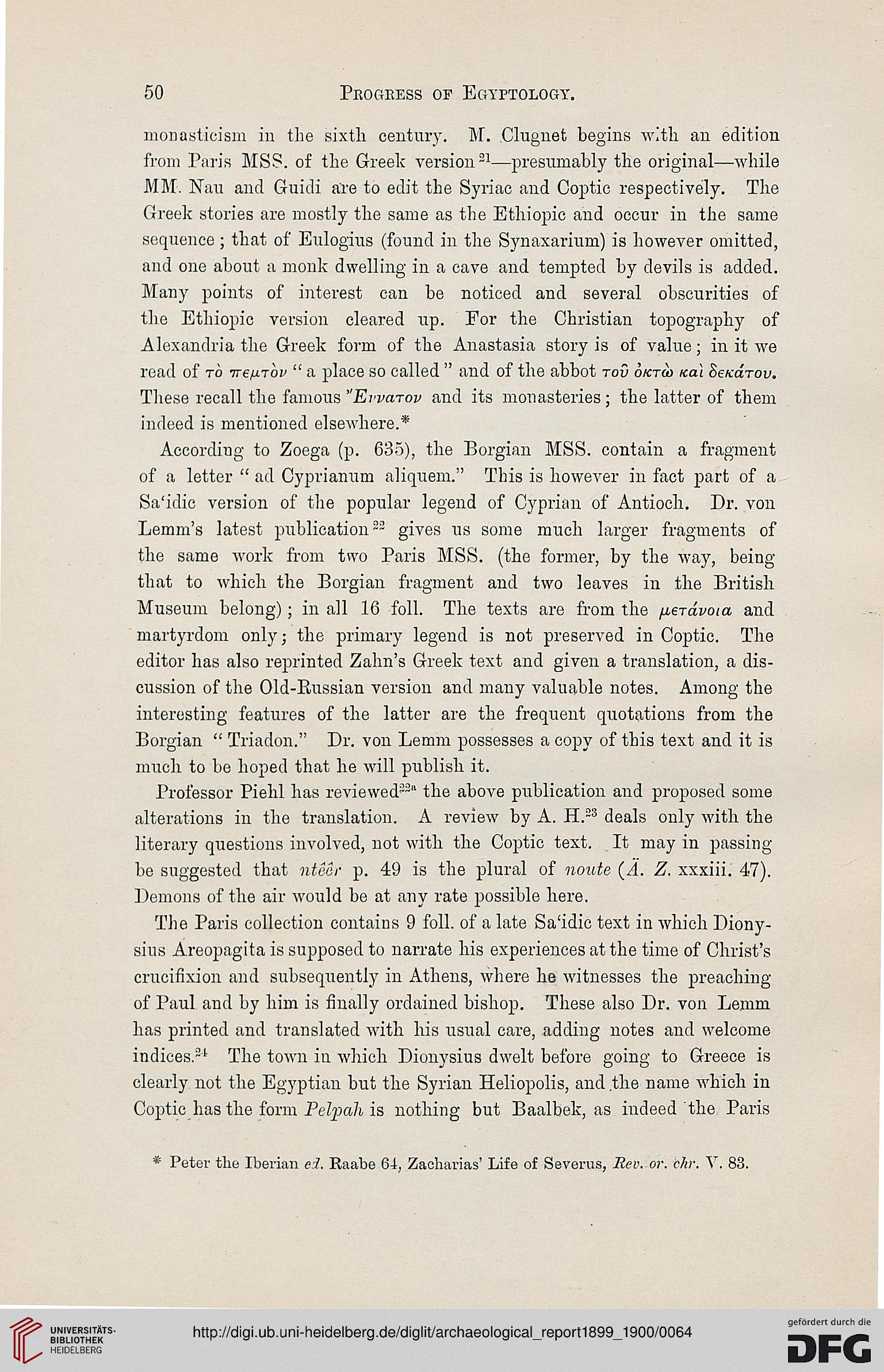50
Progress of Egyptology.
monasticism in the sixth century. M. Clugnet begins with an edition
from Paris MSS. of the Greek version21—presumably the original—while
MM. Nan and Guidi are to edit the Syriac and Coptic respectively. The
Greek stories are mostly the same as the Ethiopia and occur in the same
sequence ; that of Eulogius (found in the Synaxarium) is however omitted,
and one about a monk dwelling in a cave and tempted by devils is added.
Many points of interest can be noticed and several obscurities of
the Ethiopic version cleared up. Eor the Christian topography of
Alexandria the Greek form of the Anastasia story is of value; in it we
read of to ireixrov " a place so called " and of the abbot rov 6ktu> ml SenaTov.
These recall the famous "ErvciTov and its monasteries; the latter of them
indeed is mentioned elsewhere.*
According to Zoega (p. 635), the Borgian MSS. contain a fragment
of a letter " ad Cyprianum aliquem." This is however in fact part of a
Sa'idic version of the popular legend of Cyprian of Antioch. Dr. von
Lemm's latest publication22 gives us some much larger fragments of
the same work from two Paris MSS. (the former, by the way, being
that to which the Borgian fragment and two leaves in the British
Museum belong); in all 16 foil. The texts are from the /j,erdvoia and
martyrdom only; the primary legend is not preserved in Coptic. The
editor has also reprinted Zahn's Greek text and given a translation, a dis-
cussion of the Old-Bussian version and many valuable notes. Among the
interesting features of the latter are the frequent quotations from the
Borgian " Triadon." Dr. von Lemm possesses a copy of this text and it is
much to be hoped that he will publish it.
Professor Piehl has reviewed22" the above publication and proposed some
alterations in the translation. A review by A. H.23 deals only with the
literary questions involved, not with the Coptic text. It may in passing-
be suggested that nteor p. 49 is the plural of noute (A. Z. xxxiii. 47).
Demons of the air would be at any rate possible here.
The Paris collection contains 9 foil, of a late Sa'idic text in which Diony-
sius Areopagita is supposed to narrate his experiences at the time of Christ's
crucifixion and subsequently in Athens, where he witnesses the preaching
of Paul and by him is finally ordained bishop. These also Dr. von Lemm
has printed and translated with his usual care, adding notes and welcome
indices.2' The town in which Dionysius dwelt before going to Greece is
clearly not the Egyptian but the Syrian Heliopolis, and the name which in
Coptic has the form Pelpah is nothing but Baalbek, as indeed "the Paris
* Peter the Iberian ei. Kaabe 64, Zacharias' Life of Severus, Rev. or. bhr. V. 83.
Progress of Egyptology.
monasticism in the sixth century. M. Clugnet begins with an edition
from Paris MSS. of the Greek version21—presumably the original—while
MM. Nan and Guidi are to edit the Syriac and Coptic respectively. The
Greek stories are mostly the same as the Ethiopia and occur in the same
sequence ; that of Eulogius (found in the Synaxarium) is however omitted,
and one about a monk dwelling in a cave and tempted by devils is added.
Many points of interest can be noticed and several obscurities of
the Ethiopic version cleared up. Eor the Christian topography of
Alexandria the Greek form of the Anastasia story is of value; in it we
read of to ireixrov " a place so called " and of the abbot rov 6ktu> ml SenaTov.
These recall the famous "ErvciTov and its monasteries; the latter of them
indeed is mentioned elsewhere.*
According to Zoega (p. 635), the Borgian MSS. contain a fragment
of a letter " ad Cyprianum aliquem." This is however in fact part of a
Sa'idic version of the popular legend of Cyprian of Antioch. Dr. von
Lemm's latest publication22 gives us some much larger fragments of
the same work from two Paris MSS. (the former, by the way, being
that to which the Borgian fragment and two leaves in the British
Museum belong); in all 16 foil. The texts are from the /j,erdvoia and
martyrdom only; the primary legend is not preserved in Coptic. The
editor has also reprinted Zahn's Greek text and given a translation, a dis-
cussion of the Old-Bussian version and many valuable notes. Among the
interesting features of the latter are the frequent quotations from the
Borgian " Triadon." Dr. von Lemm possesses a copy of this text and it is
much to be hoped that he will publish it.
Professor Piehl has reviewed22" the above publication and proposed some
alterations in the translation. A review by A. H.23 deals only with the
literary questions involved, not with the Coptic text. It may in passing-
be suggested that nteor p. 49 is the plural of noute (A. Z. xxxiii. 47).
Demons of the air would be at any rate possible here.
The Paris collection contains 9 foil, of a late Sa'idic text in which Diony-
sius Areopagita is supposed to narrate his experiences at the time of Christ's
crucifixion and subsequently in Athens, where he witnesses the preaching
of Paul and by him is finally ordained bishop. These also Dr. von Lemm
has printed and translated with his usual care, adding notes and welcome
indices.2' The town in which Dionysius dwelt before going to Greece is
clearly not the Egyptian but the Syrian Heliopolis, and the name which in
Coptic has the form Pelpah is nothing but Baalbek, as indeed "the Paris
* Peter the Iberian ei. Kaabe 64, Zacharias' Life of Severus, Rev. or. bhr. V. 83.





